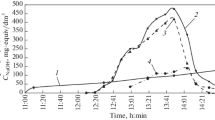Abstract—
The quality of the coolant at combined heat and power plants (CHPPs) can be improved by upgrading the water chemistry and its support systems. In the context of this problem, we should analyze the experience gained in operating the equipment, determine the advantages and disadvantages of the employed technologies and apparatuses, and propose promising solutions with the maximum use of reliable and environmentally friendly materials and process developments. A new water chemistry based on amine-containing reagents has been mastered at Russian CHPPs. The paper presents examples of the use of domestic complex reagents under the VTIAMIN brand, which differ from imported equivalents in composition and have been tested in actual applications at CHPPs, in implementing the proper water chemistry in the main and auxiliary coolant circuits. Membrane-based water treatment plants (WTPs) are used at CHPPs together with conventional WTPs. The results of the inspection of several WTPs at CHPPs are presented, and schemes combining ion-exchange and membrane processes are proposed to decrease the consumption of reagents and reduce the amount of effluents with a high process reliability of the equipment. Promising information technologies are widely applied at CHPPs. The potential is demonstrated for developing digital systems for chemical-process monitoring of the water chemistry based on the new generation of Russian-made analyzers.







Similar content being viewed by others
REFERENCES
S. P. Filipov and M. D. Dil’man, “CHP plants in Russia: The necessity for technological renovation,” Therm. Eng. 65, 775–790 (2018). https://doi.org/10.1134/S0040601518110022
A. F. Bogachev, Yu. A. Radin, and O. B. Gerasimenko, Specific Features of Operation and Damageability of Waste-Heat Boilers of Binary Steam-Gas Plants (Energoatomizdat, Moscow, 2008) [in Russian].
T. I. Petrova, K. A. Orlov, and R. B. Dooley, “International water and steam quality standards on thermal power plants at all-volatile treatment,” Therm. Eng. 63, 896–902 (2016). https://doi.org/10.1134/S0040601516100086
S. Yu. Suslov, A. V. Kirilina, I. A. Sergeev, T. V. Zezyulya, E. A. Sokolova, E. V. Eremina, and N. V. Timofeev, “Complex amine-based reagents,” Therm. Eng. 64, 237–241 (2017). https://doi.org/10.1134/S0040601517030065
A. V. Kirilina, S. Yu. Suslov, V. V. Kozlovskii, and A. B. Larin, “Water chemistry development for a thermal power plant circulating cooling system using the VTIAMIN EKO-1 chemical agent,” Therm. Eng. 66, 750–759 (2019). https://doi.org/10.1134/S0040601519100021
S. Yu. Suslov and A. V. Kirilina, “On the choice of reagents for the maintenance of amine regimes,” Energetik, No. 1, 39–44 (2011).
L. G. Vasina, A. V. Boglovskii, S. V. Sidorova, and O. V. Guseva, “Application of AMINATE TM PK-2 in the organization of water chemistry of Zakamskaya TETs-5 combined heat and power plant,” Nov. Ross. Elektroenerg., No. 5, 31–42 (2009).
O. V. Guseva and M. V. Butakova, “The results of the implementation of the combined water chemistry of steam boilers using the reagent AMINAT TM PK-2,” Nov. Ross. Elektroenerg., No. 4, 12–20 (2020).
V. F. Tyapkov, S. V. Erpyleva, and V. V. Bykova, “Introduction of water chemistry conditions of the secondary coolant circuit with metering organic amines at nuclear power stations equipped with VVER-1000 reactors,” Therm. Eng. 56, 370–377 (2009).
O. V. Guseva, A. V. Boglovskii, and E. A. Sipilina, “Development and study of compositions based on neutralizing amines to limit corrosion of the condensate feed path of thermal power plants,” Nov. Ross. Elektroenerg., No. 2, 42–53 (2012).
A. B. Larin and B. M. Larin, “Improvement of chemical monitoring of water-chemistry conditions at thermal power stations based on electric conductivity and pH measurements,” Therm. Eng. 63, 374–378 (2016). https://doi.org/10.1134/S0040601516030058
B. M. Larin and E. B. Yurchevskii, “Problems of ion-exchange and membrane water treatment technologies in power engineering,” Therm. Eng. 66, 744–749 (2019). https://doi.org/10.1134/S0040601519100033
Rules of Technical Operation of Power Plants and Grids of the Russian Federation (SPO ORGRES, Moscow, 2003) [in Russian].
STO 70238424.27.100.013-2009. Water Treatment Plants and Water Chemistry of Thermal Power Plants. Conditions of Creation. Norms and Requirements (InVEL, Moscow, 2009).
A. F. Bogachev, R. K. Mavritskaya, V. Ya. Kyshtymov, L. M. Anan’ina, and A. B. Remezentsev, “Experimental-commercial tests of a drum boiler (10 MPa) for corrective helamin treatment of its steam-generating circuit,” Therm. Eng. 49, 555–560 (2002).
S. Yu. Suslov, V. I. Kozlovskii, and V. V. Kozlovskii, “Corrosion and scaling inhibitor for treatment of water of thermal networks and other heating systems,” RF Patent No. 2693243, C23F 11/167, C23F 14/02, Application No. 2019103540 (2019).
A. A. Panteleev, V. V. Bobinkin, S. Yu. Larionov, B. E. Ryabchikov, V. B. Smirnov, and D. A. Shapovalov, “Methodological approaches to conducting pilot and proof tests on reverse-osmosis systems: Results of comparative studies,” Therm. Eng. 64, 781–786 (2017). https://doi.org/10.1134/S0040601517100093
E. B. Yurchevskii and V. V. Solodyannikov, “Computational–experimental verification of technologies of utilization of the concentrate formed in the reverse-osmosis water demineralization cycle,” Therm. Eng. 65, 487–492 (2018). https://doi.org/10.1134/S0040601518070091
B. M. Larin, E. N. Bushuev, N. A. Eremina, and M. E. Kolodyazhnaya, “Modernization of a typical water treatment installation of a thermal power plant,” Elektr. Stn., No. 11, 2–8 (2020).
A. B. Larin, B. M. Larin, A. N. Korotkov, and M. Yu. Oparin, “Improvement of the technology for treating water with a high content of iron-organic impurities for the power unit of steam-gas plants of Ivanovo,” Vestn. IGEU, No. 2, 51–56 (2009).
A. B. Larin, B. M. Larin, and E. N. Bushuev, “Determination of salt component concentrations in boiler water using conductivity and pH measurements,” Therm. Eng. 66, 593–598 (2019). https://doi.org/10.1134/S0040601519080056
B. M. Larin, A. B. Larin, A. Ya. Sorokina, and S. V. Kiet, “Method of pH determination of low-buffer extremely diluted condensate-type solutions,” RF Patent No. 2573453, G01N 21/27, G01N 33/18, Application No. 2014133634/28 (2016).
Funding
The work was funded by the Russian Foundation for Basic Research (grant no. 20-08-00432).
Author information
Authors and Affiliations
Corresponding author
Ethics declarations
The authors declare that they have no conflicts of interests.
Additional information
Translated by T. Krasnoshchekova
Rights and permissions
About this article
Cite this article
Larin, A.B., Larin, B.M., Kirillina, A.V. et al. The New Generation of CHP Plants: Water Chemistry and Its Support Systems. Therm. Eng. 69, 137–147 (2022). https://doi.org/10.1134/S0040601522020033
Received:
Revised:
Accepted:
Published:
Issue Date:
DOI: https://doi.org/10.1134/S0040601522020033




